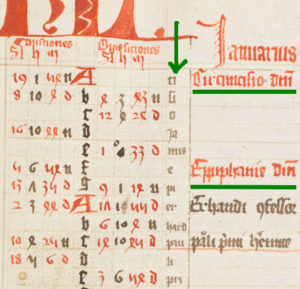I thought I’d post up a quick thought that came to me just now while looking at Fribourg Bibliothèque cantonale et universitaire Ms. L 309 (which is yet another volkskalender, naturally). There, the page for January (f2r) begins as follows (top left):
Here, underlined in green (by me), you can see the first two big feasts of the year – 1st January (“Circumcisio Domini”) and 6th January (“Epiphania Domini”). You can also see (beneath the green arrow) the famous “Cisiojanus” mnemonic, one syllable per day.
Cisiojanus
I first posted about “Cisiojanus” back in 2009, after Steve Herbelin had suggested that the circular diagram on Voynich Manuscript page f67r2 might possibly contain at least some of it in its text. What’s particularly interesting here is that while the usual version of the mnemonic begins…
- cí → circumcisio domini, the Feast of the Circumcision
- si → (continuation)
- o → (continuation)
- ján → (a reminder that this is the couplet for January)
- us → (a reminder that this is the couplet for January)
- ep → epiphanias, Epiphany
- í → (continuation)
- si → (null)
- bi → (null)
…what we see in Ms L 309 is subtly different…
- cí → circumcisio domini, the Feast of the Circumcision
- si → (continuation)
- o → (continuation)
- ján → (a reminder that this is the couplet for January)
- us → (a reminder that this is the couplet for January)
- ep → epiphanias, Epiphany
- í → (continuation)
- er → erhard, short for St. Erhard of Regensburg (whose feast day is 8th January)
- hard → (continuation)
What seems to me to have happened here is that the Cisiojanus mnemonic had, in a previous version of the same calendar, been adapted for a south-western German audience. That is, the otherwise meaningless “si-bi” syllable pair in the original version had been replaced by “er-hard” to include the local saint’s name, so that his 8th January feast day would be remembered and celebrated in the couplet. And yet the scribe copying this particular manuscript didn’t seem to know who St Erhard was (he was an Irish missionary to Bavaria, who later became “auxiliary bishop of Ratisbon and possibly the abbot of Ebersheimmunstet Abbey“), because he miscopied the feast name as “Erhandi”. *sigh*
As background, the Fribourg description for Ms L 309 says that it came from “Sud-ouest de l’Allemagne“, and that the calendar section (starting on f2r) was “Très probablement du diocèse de Constance ou de Bâle; une main cursive du XVe s. a introduit dans les mois d’octobre et novembre des célébrations typiquement lausannoises (par exemple la dédicace de Lausanne au 20 oct. et S. Himier au 12 nov.).” So if this is correct, it would seem that we can loosely map the transmission path from this document from south-east Germany (where Regensburg is, in Bavaria) to south / south-west Germany, purely on the basis of the Cisiojanus adaptation.
Hence what I’m starting to think is that, zodiac crossbowmen aside, there may well be a large number of internal local features – e.g. local adaptations to the Cisiojanus mnemonic, along with local feasts and many others – that we could sensibly use to determine the transmission paths and relationships between Volkskalender B documents. It’ll need a little more consideration, for sure, but this could very easily be moving in the right kind of direction.
And finally… Voynich labels, perhaps?
Doubtless this has been suggested before (though a brief check revealed nothing)… but could it be that the Voynich zodiac labels actually hold nothing more than the syllables of a Cisiojanus mnemonic? If so, then as long as you have the right month – and the right local adaptation of the mnemonic, of course – a modern codebreaker might possibly be able to use the zodiac labels on that page as a “block paradigm” match (though you’d also need some good guesses about the correct order and direction of the circular rings of labels to follow).
For example: even though the Voynich Pisces zodiac page has “marc / mars” written over it, I suspect that the month accompanying it is in fact more likely (based on those places where Volkskalender B zodiac roundels accompany months) to be February. In which case, one version (given on the German Cisiojanus Wikipedia page) of the February Cisiojanus rhyme is:
brí pur blásus ag dór ¦ febru áp scolástica válent
júli cónjungé ¦ tunc pétrum mátthiam índe
Don’t say I don’t spoil you with good stuff. 🙂

Nick: Great job. Keep soldiering on!